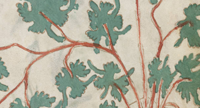origins of life
On Namang, life originated much like it (presumably) did on Earth: specific combinations of life-related chemical compounds formed in the deep ocean, possibly near hydrothermal vents, and unicellular life was born. Indigenous life is incredibly similar to Earth life; cells use a combination of DNA and RNA to function, manufacturing proteins, consuming energy in the form of light or other lifeforms, and so forth. We can divide the strains of life native to Namang into two domains: Protonamangae and Neonamangae. Protonamangae are typical examples of unicellular life. Neonamangae, however, are notable for the presence of weak psionic capabilities. The mechanism through which these abilities function is not well-understood. However, we know the limitations. Using these abilities expends a great deal of energy. At the microscopic level, the psionics seem limited to: a "forcefield" which a given microbe can project; the ability to bring inanimate particles from a short range into range of the microbe itself; a seeming ability to "sense" their surroundings that can not be explained by other cell organelles. There does not seem to be an conscious decision on the part of Neonamangae microbes on when and how to use these abilities; they are purely instinctual.
Neonamangae function as semi-colonial organisms. When many distinct organisms come together, their psionic capabilities strengthen (seemingly) exponentially. Certain colonies of millions of Neonamangae microbes have been recorded manipulating objects up to 10 grams.
introduction of earth biota
The microbal indigenes of Namang helped to craft an uncannily Earth-like environment. This resemblance was noted by an unknown alien intelligence, traditionally refered to as the Transplanters. The Transplanters, while leaving no physical trace whatsoever, took great interest in establishing "reserve colonies" of multicellular life. Indeed, they seemingly monitor thousands upon thousands of solar systems for signs of multicellular life, as they moved hundreds of stable populations of the earliest species of multicellular life on Earth to Namang. This move, referred to as Transplant 1 (or T-1), was the first of five waves of transplants. T-1 likely occurred in the early Ediacaran. Few, if any, T-1 organisms have extant survivors at the present day. Their fossil record is spotty, but present. Apparently, the Transplanters took great care to ensure healthy breeding populations, and to place their captives into appropriate biomes.
T-2 occurred during the late Cambrian; T-3 during the Carboniferous; T-4 during the early Triassic; T-5 during the early Paleogene; T-6 during the late Neogene. Each of these transplants has left extant descendants in modern Namang, although in many cases these descendants are heavily modified from their ancestral form, and/or highly restricted in habitat or niche. As an example, trilobites and halwaxiids survive in the frigid waters of the South Pole.
In contrast, some lineages went extinct on Namang that survive on Earth. For instance, no species of lemur survives on Namang. Of the species that went extinct, many others evolved to fill their niche(s). Another example: although the genus Bubalus, containing water buffalo, never flourished on Namang, another bovine - a Syncerus species - evolved to navigate swampy wetlands.
human life
T-6 happened to include populations of Homo habilis or a closely related human species. Unsurprisingly, Homo xenos evolved - a species of sapient human closely related to Earth's own Homo sapiens. These humans went on to create countless cultures and societies throughout Namang, just like their extraplanetary cousins.
Unlike Earth, more than one human or near-human species survives to the present day. In addition to Homo xenos, Namang is also home to Homo melos and Paranthropus sapiens. Currently, little is known about these two species. They do not have even a fraction of the range of H. xenos; H. melos is restricted to heavily-forested mountains on the continent of Tays, while P. sapiens is restricted to the western peninsula of the continent of Urruh and the large island of Ru. Both species are able to use true language, although it is worth noting that all P. sapiens languages seem to be bimodal, using both speech and hand sign simultaneously.
